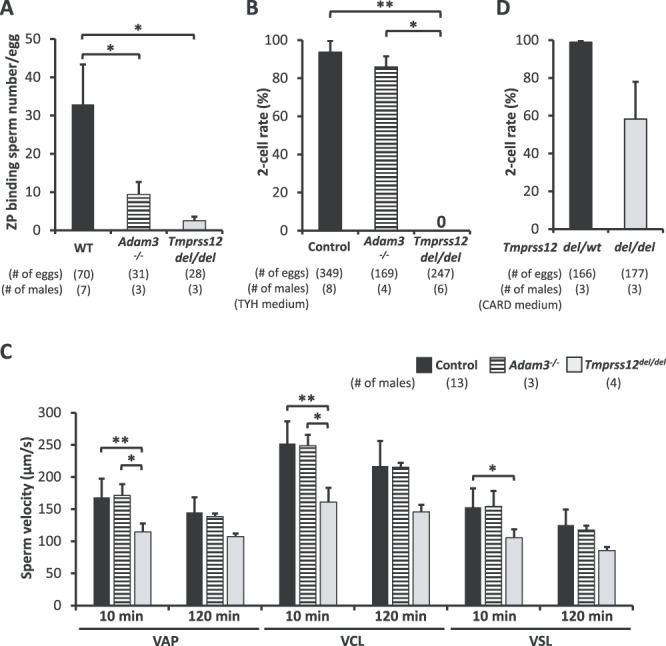Figure 4.

Fertilizing ability and motility analysis of spermatozoa from Tmprss12 del/del mice. (A) Average numbers of ZP binding spermatozoa in vitro. The number of ZP binding spermatozoa in Tmprss12del/del mice (2.49 ± 1.07 spermatozoa), and Adam3−/− mice (9.40 ± 3.23 spermatozoa) were significantly reduced compared to that of WT mice (32.93 ± 10.43 spermatozoa). *P < 0.05. (B) IVF rates in TYH using spermatozoa from control, Adam3−/−, and Tmprss12del/del mice. Average fertilization rates of control, spermatozoa from Adam3−/−, and Tmprss12del/del mice were 93.7 ± 6.0%, 85.9 ± 5.7%, and 0%, respectively. Spermatozoa from WT and Tmprss12del/wt mice were used as controls. *P < 0.05, **P < 0.01. (C) Computer-assisted sperm analysis motility parameters; (left to right) average path velocity (VAP), curvilinear velocity (VCL), straight line velocity (VSL). Spermatozoa were incubated in capacitation medium (TYH) and motility measured at 10 min (uncapacitated) and 120 min (capacitated) to assess motility before and after capacitation. More than 200 spermatozoa were analyzed for each male. Spermatozoa from WT, Tmprss12d8/wt, and Tmprss12del/wt mice were used as controls. Tmprss12del/del KO sperm velocity decreased compared to those of controls and Adam3 KO males. *P < 0.05, **P < 0.01. (D) In vitro fertilization rates spermatozoa from Tmprss12del/wt and Tmprss12del/del mice in CARD medium. Average fertilization rates of spermatozoa from Tmprss12del/wt and Tmprss12del/del mice were 98.8 ± 1.0 and 58.2 ± 19.7, respectively.
